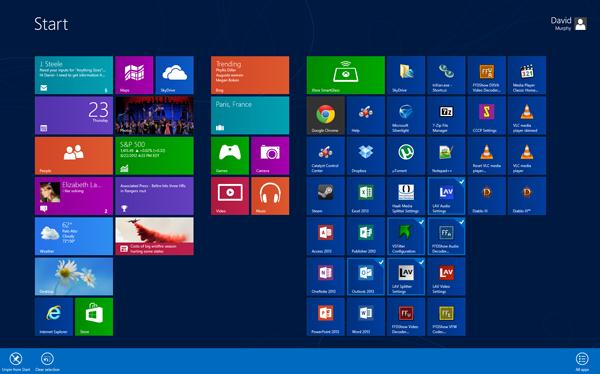You might have heard about Microsoft’s new Operating System Windows 8 and now you are wondering if you should upgrade?
Microsoft has made substantial changes to their product compared to previous versions. The most noticeable thing for every user is the user interface and that part was completely redesigned. With Windows 8, Microsoft is starting to move away from the old way where the desktop is your main screen and your start menu is your navigation. The new interface which is based on the “Metro” codenamed design is almost entirely built and optimized for touchscreen devices.
The new Windows 8 Start Screen:

The Windows desktop is not (yet) gone, but it is missing the well acquainted Start Menu. Applications can either run on the desktop or inside the Metro Screen, two completely separate things. Installed applications place their shortcuts that used to be in the start menu under a program specific folder on the Metro screen. Your Start Screen can and will get cluttered quickly. Searching is easy, just start typing when on the Metro screen, but if you are looking for files or settings and not a program name, the right category needs to be selected. Windows 8 uses so-called hot corners. All corners are used to access certain menus, just move the cursor there and options will populate. Unfortunately this is not very intuitive at first. These are some noticeable facts about the new user interface but there is a lot more to learn, love, or, in some cases, hate.
Some nice characteristics of Windows 8 should not be left out. It installs very easily and boot or shuts down super quick. For optimal performance, you should have a minimum of 2GB of memory and 20GB of disk space on your computer to install Windows 8. Hardware resources are used very sparingly during operation which explains the better performance compared to older versions of Windows. Windows Defender now completely includes Security Essentials (Microsoft’s free anti-virus program) into the system and provides a solid out of the box security level. The Task Manager and Windows Explorer have also been improved and provide more information and options for the end user. If you like to use a Microsoft Live (Hotmail) account, you can now synchronize settings, bookmarks, passwords and more with it and use those on other PCs when you login. Lastly, Microsoft has made it easier to restore the system or completely reset it to its original installation state.
Before you buy a new computer with Windows 8 or consider upgrading your current system it is advisable that you read or watch a few reviews or better get your hands on a system with Windows 8 and try it out.
The following videos will provide a few more details about Windows 8 and give some visual impressions about the new operating system:
http://www.youtube.com/watch?v=X0fsyb-ttcw